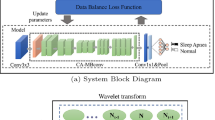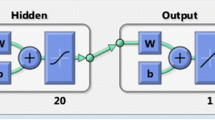Abstract
In this paper a method for sleep apnea classification is proposed. The method is based on a feedforward neural network trained using a bayesian framework and a cross-entropy error function. The inputs of the neural network are the first level-5-detail coefficients obtained from a discrete wavelet transformation of the samples of the thoracic effort signal corresponding to the apnea. In order to train and validate the presented method, 120 events from 6 different patients were used. The true error rate was estimated using a 10-fold cross validation. The presented results were averaged over 100 different simulations and a multiple comparison procedure was used to model selection. The mean classification accuracy obtained over the test set was 83.78%±1.90.
Access this chapter
Tax calculation will be finalised at checkout
Purchases are for personal use only
Preview
Unable to display preview. Download preview PDF.
Similar content being viewed by others
References
Thorpy, M.J.: Handbook of Sleep Disorders. Marcel Dekker, Inc., New York (1990)
Dagum, P., Galper, A.: Forecasting sleep apnea with dynamic networks. In: Proc. 9th Conf. on Uncertainty in Artificial Intelligence, pp. 64–71. Morgan Kaufmann, San Francisco (1993)
Rauscher, H., Popp, W., Zwick, H.: Computerized detection of respiratory events during sleep from rapid increases in oxyhemoglobin saturation. Lung, 335–342 (1991)
George, C.F., Millar, T.W., Kryger, M.H.: Identification and quantification of apneas by computer-based analysis of oxygen saturation. Am. Rev. Respir. Dis. 137, 1238–1240 (1988)
Oliveira, J.M., Tomé, A.M., Cunha, J.P.: Sleep data integration and analysis - an object oriented approach. In: Proc. 15th Annual International Conference of the IEEE Engineering in Medicine and Biology Society, pp. 455–456 (1993)
Cabrero-Canosa, M., Castro-Pereiro, M., Graña-Ramos, M., Hernández-Pereira, E., Moret-Bonillo, V., Martín-Egana, M., Verea-Hernando, H.: An intelligent system for the detection and interpretation of sleep apneas. Expert System with Applications, pp. 335–349 (2003)
Hernández-Pereira, E., Carrillo-Rozas, N., Cabrero-Canosa, M., Moret-Bonillo, V.: Detección y clasificación de apneas de sueño mediante wavelets y redes de neuronas artificiales. In: Lasaosa, P.L., Gassó, S.O., Gascón, G.M., Cortés, J.P.M. (eds.) Proc. XX Congreso Anual de la Sociedad Española de Ingeníería Biomédica, pp. 199–202 (2002)
Rao, R.M., Bopardikar, A.S.: Wavelet Transformations. In: Introduction to Theory and Applications, Addison-Wesley, Reading (1998)
Hornik, K., Stinchcombe, M., White, H.: Multilayer feedforward networks are universal approximators. Neural Networks 2, 359–366 (1989)
Bridle, J.: Probabilistic interpretation of feedforward classification network outputs, with relationships to statistical pattern recognition. In: Fogelman-Soulie, F., Herault, J. (eds.) Neurocomputing: Algorithms, Architectures and Applications, New York, pp. 227–236. Springer, Heidelberg (1990)
MacKay, D.J.C.: A practical bayesian framework for backprop networks. Neural Computation 4, 448–472 (1992)
MacKay, D.J.C.: The evidence framework applied to classification networks. Neural Computation 4, 720–736 (1992)
Bishop, C.M.: Neural Networks for Pattern Recognition. Oxford University Press, New York (1995)
Hinton, G.E.: Learning translation invariant recognition in massively parallel networks. In: Nijman, A.J., de Bakker, J., Treleaven, P.C. (eds.) PARLE Conference on Parallel Architectures and Languages Europe, Berlin, pp. 1–13. Springer, Heidelberg (1987)
Nielsen, H.: UCMINF - An algorithm for unconstrained, nonlinear optimization. Technical Report IMM-REP-2000-0019, Department of Mathematical Modelling. Technical University of Denmark (2000)
Hollander, M., Wolfe, D.A.: Nonparametric Statistical Methods. John Wiley & Sons, Chichester (1973)
Hsu, J.C.: Multiple Comparisons. Chapman&Hall/CRC, Boca Raton (1996)
Zemen, T., Clabian, M., Pfützner, H.: Classification of sleep apnea events by means of radial basis function networks. In: International ICSC/IFAC Symposium on Neural Computation (NC 1998), pp. 351–357 (1998)
Author information
Authors and Affiliations
Editor information
Editors and Affiliations
Rights and permissions
Copyright information
© 2003 Springer-Verlag Berlin Heidelberg
About this paper
Cite this paper
Fontenla-Romero, O., Guijarro-Berdiñas, B., Alonso-Betanzos, A., del Rocío Fraga-Iglesias, A., Moret-Bonillo, V. (2003). A Bayesian Neural Network Approach for Sleep Apnea Classification. In: Dojat, M., Keravnou, E.T., Barahona, P. (eds) Artificial Intelligence in Medicine. AIME 2003. Lecture Notes in Computer Science(), vol 2780. Springer, Berlin, Heidelberg. https://doi.org/10.1007/978-3-540-39907-0_39
Download citation
DOI: https://doi.org/10.1007/978-3-540-39907-0_39
Publisher Name: Springer, Berlin, Heidelberg
Print ISBN: 978-3-540-20129-8
Online ISBN: 978-3-540-39907-0
eBook Packages: Springer Book Archive




